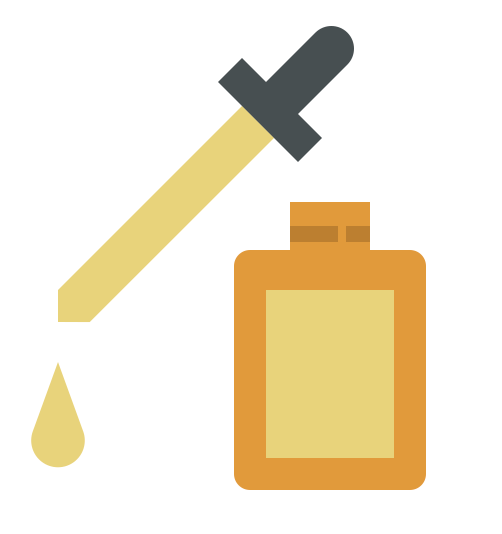
The cosmetics sector in the United States
Cannabis and Cosmetics for the US Market
Market trends for cannabis-based cosmetic products in America
https://www.exportusa.eu/cosmetics-trends-cbd-america.php (+1) 718-5225575
(+1) 718-5225575
Beauty purchasing patterns in America are changing. Again. Department stores used to be the go-to for American consumers to buy new cosmetics and make-up. Then came what are now considered the largest beauty retailers in the United State: Sephora and Ulta Beauty (an Illinois-based salon chain). Now another major evolution in the beauty world is underway, with U.S. retail giants, and even pharmacies, ready to jump into the beauty business fray.
My first 'luxury' beauty experience was in a department store in the mid-1990s. My mother took me to the Clinique counter to get that moisturizer in the yellow bottle (all Millennials and earlier generations know what I'm talking about). When I graduated from college, I went to Saks and bought a Bobbi Brown foundation and a 'shimmer brick' highlighter that I had no idea how to use. In high school, the Chanel eyeshadow palette from Macy's was a prized possession. Today, I would never even consider going to a department store to buy makeup or skincare products. In America, Sephora and Ulta Beauty are now the go-to destinations for beauty product purchases, with thousands of stores in the United States and exclusive deals to sell the most sought after brands to American consumers.
But history (might) repeat itself. Big retailers like Target and Walmart have realized that they have an opportunity in the beauty business: with thousands of stores across the United States, each with super-long aisles, they could become the perfect place to discover new beauty labels. Additionally, pharmacies want their slice of the pie, too: CVS recently announced its 'Skin Care Center' concept, an area where inexpensive brands like Cerave will be joined by more prestigious lines typically associated with Sephora or Net-a-Porter, including Wander Beauty. Now that Target, Walmart and CVS are vying to grab market share from Ulta and Sephora, while Saks, Bloomingdale's and Nordstrom are investing to revamp their beauty departments, experts wonder if there will be room for everyone.
The location used to be critical to discovering the latest beauty products. Sephora, for example, dictated trends with the launch of new products. The fact that it had acquired a new cosmetics or makeup line immediately made American consumers trust the newly discovered brand. Only insiders were familiar with the Drunk Elephant brand when it entered Sephora in 2015; but it wasn't long before the chain's customers began spending $100 on this new brand's serums. After achieving success at Sephora, the cosmetics landed at Ulta Beauty and, years later, in the mainstream market. Rarely did these brands reach large U.S. retailers and drugstores, which in the eyes of American consumers were perceived as places to buy at most basic products such as Dove soap or Pantene shampoo.
But now the world has changed. Now, American consumers discover products on social media and the like. And the place where they buy the product is of little importance: it makes no difference if the purchase happened during a trip to Sephora or in an aisle at CVS. Big retailers and pharmacies in the US know this and want to take advantage of it. The democratization of beauty - the mix of high and low-priced items and the end of the mindset that expensive means 'better' - has made beauty brands more willing to expand their distribution to mainstream channels. It took decades for America to move from buying beauty products in department stores to specialty chains. But the shift from specialty retailers to American mass retailers and, potentially, pharmacies is happening much faster.
Right now, Target is the one that has made the biggest foray into the world of cosmetics and make-up in America, following the 'Ulta-fication' of its beauty aisles in 2019, designed to make shoppers feel like they were in a beauty salon inside a large supermarket chain. Ulta opened about 100 shops-in-shops at Target last year, and aims to open another 250 in 2022. Target has spent years attracting start-ups and d2c digital native beauty brands such as Harry's, Quip and Native to differentiate its beauty range from competitors.
Last year, Walmart introduced about 100 new beauty brands under the leadership of then VP and general manager of the beauty department, Musab Balbale. Balbale left Walmart earlier this year to join CVS as general manager. Intending to become a beauty destination, CVS is introducing labels that traditionally have never been found (or bought) in a U.S. pharmacy.
Each store has its own strength in this new democratized market: Sephora is still considered a beauty industry leader and trendsetter with its exclusive brands. Walmart focuses on sales volume: it is the largest retailer in the world, with about half of the U.S. population visiting the large chain at least once a week. Target is somewhere in between: where American consumers go to buy toilet paper and milk, but many shoppers also see it as a store where they can discover exciting new products. CVS is the wild card: they are everywhere (nearly 10000 stores in the United States, five times the number of Target stores). Here American consumers come in to buy basic necessities and generally do not linger to see what else is on the shelves. The U.S. chain's new marketing strategy aims to change the point of view of its customers: - You thought you only needed toothpaste, but how about this pink millennial illuminating blush, blush duo, and illuminating stick from Wander Beauty? - The challenge is convincing them to buy $40 beauty products and that $4 tube of toothpaste.
It is likely that if the same (beauty) item was sold at both Target, CVS, and Sephora in 2022, it would no longer influence the American consumer's choice. Buying a Too Faced 'Better Than Sex' mascara while also grabbing an Advil for headaches at Target nowadays would no longer be weird in America. Paradoxically, if the same mascara were sold in a vending machine in the nearest subway, it would still be purchased.

Market trends for cannabis-based cosmetic products in America
https://www.exportusa.eu/cosmetics-trends-cbd-america.php
2022 will be the year of all-around health in the US: consumer demand in the beauty industry has shifted to niche products that have now become must-haves
https://www.exportusa.eu/guide-cosmetic-products-us-2022.php
With the United States leading the cosmetics market, more and more celebrities are choosing to launch beauty brands in America
https://www.exportusa.eu/launch-cosmetic-brand-unitedstates.php
Selling cosmetic products on Amazon US is a great way to enter the US market
https://www.exportusa.eu/selling-cosmetics-amazon-us.php
Branding Services for the American Market: ExportUSA adapts, or {re}adapts your product and prepares it for the American market
https://www.exportusa.eu/re-branding-exportusa.php